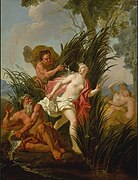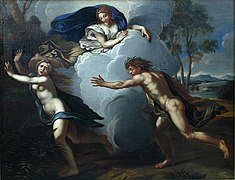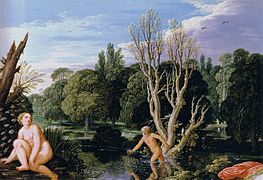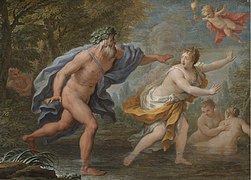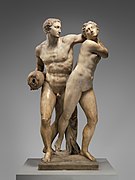Alpheus (deity)

| Part of a series on |
| Ancient Greek religion |
|---|
 |
Alpheus or Alpheios (
Family

Like most river gods, Alpheus was a son of the Titans Oceanus and his sister-wife Tethys.[4] Telegone, daughter of Pharis, bore his son, the king Orsilochus.[5] Through him, Alpheus was the grandfather of Diocles, and great-grandfather of a pair of soldiers, Crethon and Orsilochus, who were slain by Aeneas during the Trojan War.[6] The river god was also called the father of Melantheia who became the mother of Eirene by Poseidon.[7] In later accounts, Alpheus (Alphionis) was the father of Phoenissa, possible mother of Endymion by Zeus.[8]
Mythology

According to
According to other traditions,
In these accounts two or more distinct stories seem to be mixed up together, but they probably originated in the popular belief that there was a natural subterranean communication between the river
Alpheus was also the river which
Roman references
Alpheus is often associated with Antinous, the lover of the Roman Emperor Hadrian. Antinous was a Greek youth who had drowned in the Nile River. After he was deified, coins of the period depict him as Alpheios or Hadrian with Alpheios.[17]
Gallery
-
Alpheus chasing Arethusa by Antoine Coypel (18th-century)
-
Alpheus and Arethusa by René-Antoine Houasse
-
The Story of Arethusa by Francesco Primaticcio
-
Alpheus and Arethusa by Abraham Bloteling (between 1655 and 1690)
-
Alpheus and Arethusa (Roman School, circa 1640)
-
Alpheus and Arethusa by Carlo Maratta (7th-century)
-
Alpheus and Arethusa by John Martin (1832)
-
Arethusa Chased by Alpheus by Wilhelm Janson and Antonio Tempesta (1606)
-
Alpheus and Arethusa by Johann König (probably 1610s)
-
Alpheus and Arethusa by Luigi Garzi
-
Alpheus and Arethusa by Paolo de Matteis (1710)
-
Aréthuse et Alphée by Léopold Burthe (1847)
-
Arethusa
-
Scultore fiorentino, alfeo e aretusa, 1561–62
-
Alpheus and Arethusa by Battista di Domenico Lorenzi (1568–70)
See also
- Sarasvati River – River mentioned in the Vedas and ancient Indian epics, the invisible or subterranean mystical river of Hinduism
Notes
- ^ Lewis, "Two sides of the same coin", pp. 179–201.
- ^ Pindar, Nemean Odes 1.1
- ^ a b Schmitz, Leonhard (1867). "Alpheias". In William Smith (ed.). Dictionary of Greek and Roman Biography and Mythology. Vol. 1. Boston: Little, Brown and Company. pp. 133–134. Archived from the original on 2008-06-13.
- ^ Hesiod, Theogony 338; Hyginus, Fabulae Preface
- ^ Pausanias, Graeciae Descriptio 4.30.2
- ^ Homer, Iliad 5.45
- ^ Plutarch, Quaestiones Graecae 19
- Recognitions10.21-23
- Scholiast on Pindar's Nemean Odes 1.3
- ^ a b Roman, L., & Roman, M. (2010). Encyclopedia of Greek and Roman mythology., p. 56, at Google Books
- ^ Ovid, Metamorphoses 5.572; Virgil, Aeneid 3.694; Servius ad Virgil, Eclogues 10.4; Statius, Silvae 1.2, 203, Thebaid 1.271, 4.239; Lucian, Dialogi Marini 3
- ^ Pausanias, Graeciae Descriptio 6.22.5
- ^ Scholiast on Pindar's Pythian Odes 2.12
- ^ Pausanias, Graeciae Descriptio 5.14.5; Scholiast on Pindar's Olympian Odes 5.10
- ^ Strabo, Geographica 6, p. 270, 8.343; Seneca the Younger, Naturales quaestiones 3.26; Fulgentius, Mythologiarum libri 3.12
- ^ Pseudo-Plutarch, De fluviis 19
- ^ "RPC III, 309". Roman Provincial Coinage online.
References
- Fabius Planciades Fulgentius, Mythologies translated by Whitbread, Leslie George. Ohio State University Press.1971. Online version at theio.com
- Gaius Julius Hyginus, Fabulae from The Myths of Hyginus translated and edited by Mary Grant. University of Kansas Publications in Humanistic Studies. Online version at the Topos Text Project.
- Hesiod, Theogony from The Homeric Hymns and Homerica with an English Translation by Hugh G. Evelyn-White, Cambridge, MA.,Harvard University Press; London, William Heinemann Ltd. 1914. Online version at the Perseus Digital Library. Greek text available from the same website.
- Homer, Homeri Opera in five volumes. Oxford, Oxford University Press. 1920. .
- Lucius Mestrius Plutarchus, Morals translated from the Greek by several hands. Corrected and revised by. William W. Goodwin, PH. D. Boston. Little, Brown, and Company. Cambridge. Press Of John Wilson and son. 1874. 5. Online version at the Perseus Digital Library.
- Pausanias, Graeciae Descriptio. 3 vols. Leipzig, Teubner. 1903. Greek text available at the Perseus Digital Library.
- Pindar, Odes translated by Diane Arnson Svarlien. 1990. Online version at the Perseus Digital Library.
- Pindar, The Odes of Pindar including the Principal Fragments with an Introduction and an English Translation by Sir John Sandys, Litt.D., FBA. Cambridge, MA., Harvard University Press; London, William Heinemann Ltd. 1937. Greek text available at the Perseus Digital Library.
- Ante-Nicene Library Volume 8, translated by Smith, Rev. Thomas. T. & T. Clark, Edinburgh. 1867. Online version at theio.com
- Strabo, The Geography of Strabo. Edition by H.L. Jones. Cambridge, Mass.: Harvard University Press; London: William Heinemann, Ltd. 1924. Online version at the Perseus Digital Library.
- Strabo, Geographica edited by A. Meineke. Leipzig: Teubner. 1877. Greek text available at the Perseus Digital Library.
Bibliography
- Virginia M. Lewis, "Two Sides of the Same Coin: The Ideology of Gelon’s Innovative Syracusan Tetradrachm", in Greek, Roman, and Byzantine Studies, 59 (2019), pp. 179–201.
 This article incorporates text from a publication now in the public domain: Smith, William, ed. (1870). "Alpheias". Dictionary of Greek and Roman Biography and Mythology.
This article incorporates text from a publication now in the public domain: Smith, William, ed. (1870). "Alpheias". Dictionary of Greek and Roman Biography and Mythology.

